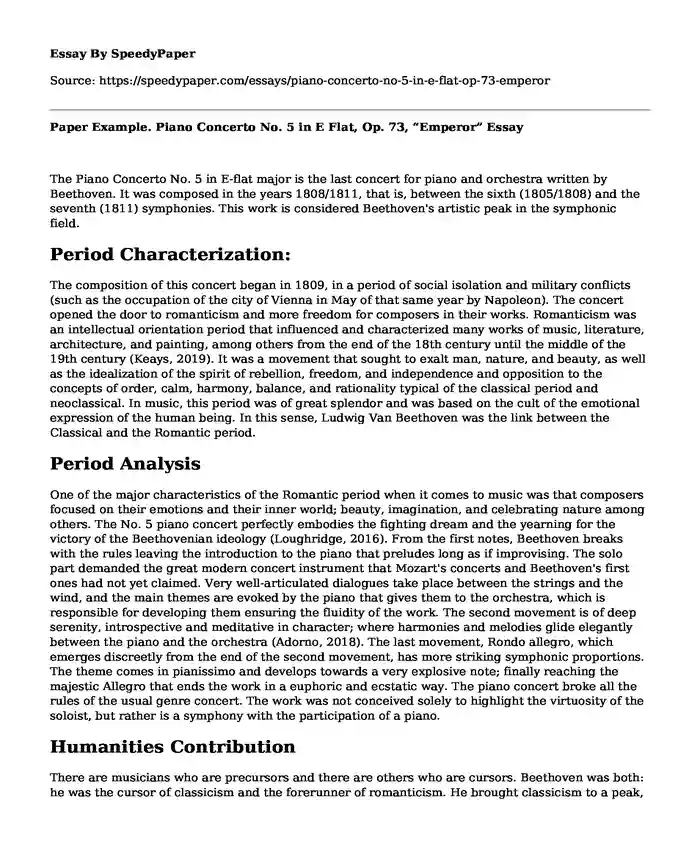
| Type of paper: | Research paper |
| Categories: | Music Culture Inspiration Analysis |
| Pages: | 3 |
| Wordcount: | 713 words |
The Piano Concerto No. 5 in E-flat major is the last concert for piano and orchestra written by Beethoven. It was composed in the years 1808/1811, that is, between the sixth (1805/1808) and the seventh (1811) symphonies. This work is considered Beethoven's artistic peak in the symphonic field.
Period Characterization:
The composition of this concert began in 1809, in a period of social isolation and military conflicts (such as the occupation of the city of Vienna in May of that same year by Napoleon). The concert opened the door to romanticism and more freedom for composers in their works. Romanticism was an intellectual orientation period that influenced and characterized many works of music, literature, architecture, and painting, among others from the end of the 18th century until the middle of the 19th century (Keays, 2019). It was a movement that sought to exalt man, nature, and beauty, as well as the idealization of the spirit of rebellion, freedom, and independence and opposition to the concepts of order, calm, harmony, balance, and rationality typical of the classical period and neoclassical. In music, this period was of great splendor and was based on the cult of the emotional expression of the human being. In this sense, Ludwig Van Beethoven was the link between the Classical and the Romantic period.
Period Analysis
One of the major characteristics of the Romantic period when it comes to music was that composers focused on their emotions and their inner world; beauty, imagination, and celebrating nature among others. The No. 5 piano concert perfectly embodies the fighting dream and the yearning for the victory of the Beethovenian ideology (Loughridge, 2016). From the first notes, Beethoven breaks with the rules leaving the introduction to the piano that preludes long as if improvising. The solo part demanded the great modern concert instrument that Mozart's concerts and Beethoven's first ones had not yet claimed. Very well-articulated dialogues take place between the strings and the wind, and the main themes are evoked by the piano that gives them to the orchestra, which is responsible for developing them ensuring the fluidity of the work. The second movement is of deep serenity, introspective and meditative in character; where harmonies and melodies glide elegantly between the piano and the orchestra (Adorno, 2018). The last movement, Rondo allegro, which emerges discreetly from the end of the second movement, has more striking symphonic proportions. The theme comes in pianissimo and develops towards a very explosive note; finally reaching the majestic Allegro that ends the work in a euphoric and ecstatic way. The piano concert broke all the rules of the usual genre concert. The work was not conceived solely to highlight the virtuosity of the soloist, but rather is a symphony with the participation of a piano.
Humanities Contribution
There are musicians who are precursors and there are others who are cursors. Beethoven was both: he was the cursor of classicism and the forerunner of romanticism. He brought classicism to a peak, from which it ceased to be classic and became romantic. The legacy of Beethoven's work is enormous. He made compositions for all kinds of instruments and styles (symphonies, chamber music, solo instruments, and vocal music among others) in which they are included in general terms: Quartets, quintets, concerts for piano, concerts for violin, symphonies, piano sonatas and one opera (Shen, 2015). Beethoven also contributed greatly to developing a balance between musical and human expression, virtuosity, and the formal structure of music at that time. The most interesting aspect of Beethoven's music is that he was able to graft different elements of disorder into music without ever losing touch with the musical rationality of his predecessors. More than that, the set of the Beethovenian work reveals a piece of music still intrinsically managed by a classical conception, which mediates the interaction between the composition and its interlocutor.
References
Adorno, T. W. (2018). Beethoven: The Philosophy of Music. New Jersey: John Wiley & Sons.
Keays, J. (2019). Piano Concerto No. 5 in E-flat major "Emperor", op. 73. Retrieved from https://www.redlandssymphony.com/pieces/piano-concerto-no-5-in-e-flat-major-op-73 on 24th September 2019.
Loughridge, D. (2016). Haydn's Sunrise, Beethoven's Shadow: Audiovisual Culture and the Emergence of Musical Romanticism. Chicago: University of Chicago Press.
Shen, Y. (2015). Narrative Analysis of Beethoven's Piano Concerto No. 5 (Doctoral dissertation). The Faculty of the Department of Music, University of Houston. Retrieved from file:///C:/Users/user/Downloads/SHEN-DOCTORALESSAYMUSIC-2015.pdf
Cite this page
Paper Example. Piano Concerto No. 5 in E Flat, Op. 73, "Emperor". (2023, Feb 15). Retrieved from https://speedypaper.com/essays/piano-concerto-no-5-in-e-flat-op-73-emperor
Request Removal
If you are the original author of this essay and no longer wish to have it published on the SpeedyPaper website, please click below to request its removal:
- Free Essay on Total Quality Management in the BT Company
- Free Paper Sample Describing Hooks for Essays to Get Your Reader Hooked
- Essay Example: Future Career Aspirations
- Free Essay: The Unified Theory of Acceptance and Use Theory (UTAUT)
- Paper Example - Binge-Watching TV
- Essay Sample on Imperfect Prediction and Health Policy
- Paper Sample. Technology Issues in Organizations
Popular categories




